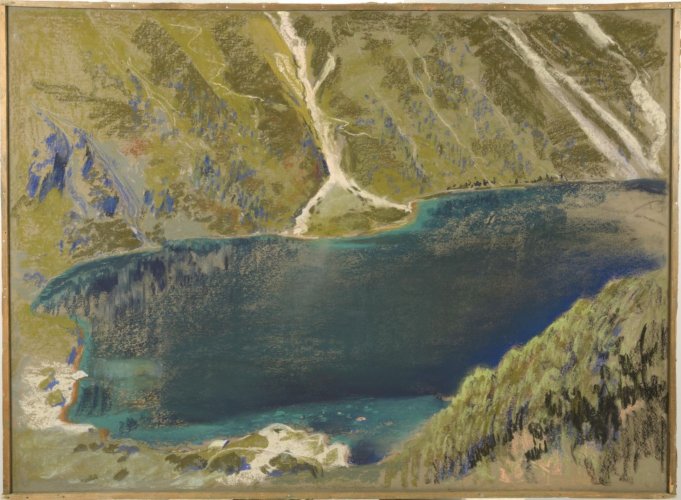Description:
Leon Wyczółkowski (1852-1936) began his education at the Warsaw Drawing Class in the years 1869-1874. He continued his studies in the studio of Alexander Wagner at the Munich Academy, and then at the Krakow School of Fine Arts with Jan Matejko. Living permanently in Krakow, from 1895 to 1911 he ran a painting workshop at the SSP. For years he exhibited his works both in Poland and in Europe, winning numerous awards. Initially, he focused on historical themes in his work. In the 80s he also dealt with salon painting and outdoor landscape painting. In the following decade, symbolic themes appeared in the artist’s work *.
Description of the painting:
Leon Wyczółkowski’s fascination with the Tatra Mountains did not escape him either, as he created a huge number of local landscapes between 1899 and 1907. Several of them were exhibited at the Rogaliński Gallery, including the perhaps most beautiful “Morskie Oko” from 1905. The discussed painting shows this most famous Tatra lake from the Czarny Staw position. Among the artist’s Tatra cycles, a frequent theme was Czarny Staw or Morskie Oko shown at different times of the day. Wyczółkowski was interested in the changes in the view under the influence of different lighting, so he painted them hour after hour. About the creation of the Rogaliński painting he wrote in his memoirs: “In one breath and in one day… At Czarny Staw, I painted Morskie Oko as if salted. I was in the shed, it was snowing, the sun rose and I painted from the other side.”*
The composition of the work allows the viewer to place himself in the same place where the painter was. “Morskie Oko” was made in pastel technique, often used by Wyczółkowski. When creating the view, the artist applied different ways of applying pastel. In the upper right corner, thick, irregular strokes are used to create a patch of green seen from a distance. The plant cover of the slope in the background was carefully shaded and then rubbed. The composition of different shades of green in this place creates a feeling of convexity and concavity reflecting the unevenness of the terrain. Small vertical strokes on the hill in the foreground create a carpet of juniper. Both planes are synthetically framed. The second seems to be slightly more clearly represented than the first. The detailed outlined snow-covered ravines and rocks revealed from under the greenery are perfectly visible. Patches of green penetrate the blues, which seem to be reflections of the lake’s surface. In the lower left corner are white spots creating the remains of snow. The most refined element of the work is the surface of Morskie Oko depicted in the center of the picture field. Created with deep navy blue in the center, closer to the shores it turns into a layout of intersecting blues depicting shallower parts and green slopes of the mountain reflected in the water. The shore in the lower right corner, well visible from the painter’s position, is exceptionally detailed, in the bright surface of the water you can see the stones that form the bottom of the lake.
Looking at “Morskie Oko” brings to mind impressionistic works. This suggests a photographic approach and a meticulous observation of nature. However, the frame captured here does not emanate randomness, but monumentality and peace flowing from nature. This makes the work “a synthesis of the mood and color-light sensations felt in nature”.*


